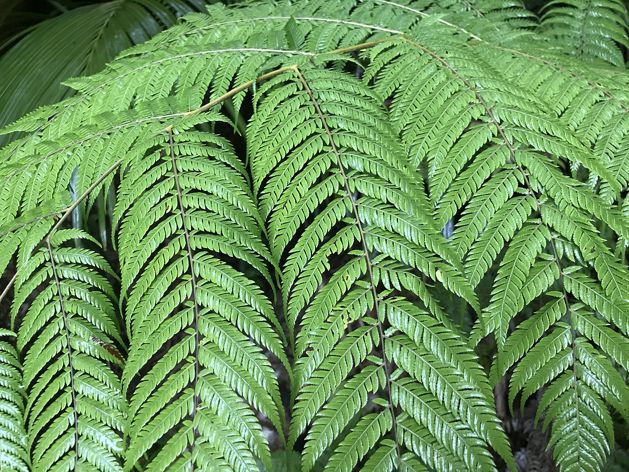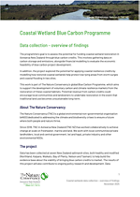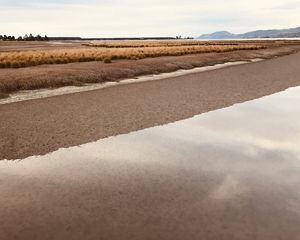Exploring Blue Carbon Potential
The Nature Conservancy explores whether blue carbon credits can help fund coastal wetland restoration.

The Nature Conservancy Aotearoa New Zealand has conducted research to assess the potential for funding coastal wetland restoration in Aotearoa New Zealand through blue carbon credits. Revenue from credits could support local communities and landowners to restore these critical ecosystems which help protect against the impacts of climate change.
In the UN Decade of Ecosystem Restoration, revitalising these valuable wetlands has become a critical international priority, following research showing that restored coastal wetlands can capture as much carbon as native forests, as well as protecting coastal communities and endangered ecosystems from the impacts of climate change.
Coastal wetland ecosystems filter water, protect communities, homes, and livelihoods from coastal erosion and storms, as well as providing vital habitat and food sources for endemic invertebrate, plant and bird species.
Researchers gathered data at seven New Zealand sites (Northland, Kaipara, Waikato, Bay of Plenty, Nelson and Tasman) on carbon storage and emissions, alongside financial modelling to evaluate the economic feasibility of blue carbon project development.
The study found that all sites in the study would have the potential to capture carbon and generate blue carbon credits. The extent to which those credits would cover the costs of restoration depends on the price carbon can be sold at, the scale of the project and the complexity of restoration. Project costs would vary greatly depending on the complexity of restoration required, ranging from approximately $20,000 (NZD) per hectare in a low-cost restoration scenario to over $350,000 per hectare when including full capital and operational expenditures.
At the scale of site tested, the carbon price would need to be anything from $300 (for sites >20 ha) to over $10,000 (for sites <10 ha) per tonne. However, combining sites and conducting restoration at larger scales is expected to lower costs and make restoration more achievable.
Having established there is potential for income from blue carbon credits, TNC NZ will carry out further investigations into finance options for restoration of coastal wetlands. These may include private and public funding for restoration to support climate resilience, or combining revenue from blue carbon credits with resilience and other biodiversity or emerging credits.
Resources such as TNC’s global Playbook for Climate Finance, and its network of experts can help to identify other ways that restoration could be economical.
About the Research
- Data Collection: Cawthron Institute, Bioeconomy Science Institute, Pattle Delamore Partners Ltd, Earth Sciences New Zealand, TNC
- Modelling and Analysis: Earth Sciences New Zealand, Tidal Research, TNC.
- Coastal Resilience Case Studies: Earth Sciences New Zealand, Pattle Delamore Partners Ltd., TNC
Researchers used the Blue Carbon Cost Tool (developed by TNC) that provides transparent economic data for blue carbon projects to create a shared understanding between investors and developers from the start.
How Blue Carbon and Other Nature Credits Work
When a coastal wetland is restored, it can capture CO2. If this carbon capture and storage is quantified and verified, it generates blue carbon credits.
Carbon credits are tradable on voluntary carbon markets for entities wanting to purchase carbon credits for their unavoidable GHG emissions. Revenue is used to fund and maintain restoration projects.
Projects must meet established standards and criteria, such as the Verified Carbon Standard or the Gold Standard, for carbon accounting and verification, alongside social and biodiversity outcomes.

We Can't Save Nature Without You
Sign up to receive monthly conservation news and updates.
Resilience Credits
Resilience credits are a new and emerging credit. Globally, TNC collaborated with partners to develop a resilience methodology under Verra’s Sustainable Development Verified Impact Standard (SD VISta). This type of credit aims to create a way to finance adaptation measures that enhance a community’s or ecosystem’s resilience to climate change.
Two sites were also surveyed for their resilience credit potential using this developing methodology. However, the study concluded that the international resilience credit methodology tested was less suitable for New Zealand’s wetlands because they have been drained and land artificially protected by stopbanks to be used for agricultural activities and urban development.
To advance the use of coastal resilience credits in New Zealand, a bespoke methodology would need to be developed that integrates coastal wetland restoration alongside coastal defence redesign/upgrades. Given the urgent need for coastal adaptation and managed retreat to protect our communities, economy and livelihoods, this provides an opportunity to reimagine how low-lying coastal landscapes are managed in New Zealand for greater public benefit.
-

Coastal Wetlands Data Collection
The report assesses the potential for funding coastal wetland restoration in Aotearoa New Zealand through blue carbon credits and identifies next steps.
Download




